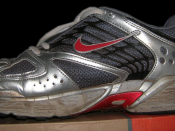NIKE is the world's #1 shoemaker in the world. Basketball players still want to be like Mike, but shoe companies want to be like NIKE. NIKE currently dominates the U.S. footwear market with about 45% of the total market. NIKE controls more than 20% of the US athletic shoe market. The company designs and sells shoes for a variety of sports, including baseball, basketball, cheerleading, golf, volleyball, hiking, tennis, and football. NIKE also sells Cole Haan dress and casual shoes and a line of athletic apparel and equipment. In addition, it operates NIKETOWN shoe and sportswear stores, NIKE factory outlets, and NIKE Women shops. NIKE sells its products throughout the US and in about 160 other countries.
In fiscal 2005, NIKE met their financial goals. The revenues grew 12% to 13.7
billion, net income grew 28% to 1.2 billion and NIKE delivered diluted earnings per share of $4.48, a 28% increase versus fiscal 2004.
The gross margin percentage increase 44.5%. The return on invested capital has improved and free cash flow from operations has increased. They continue to return cash to shareholders through dividends and share repurchases. Cash provided by operations was $1.6 billion in 2005 compared to $1.5 billion in 2004. There has been an improvement in cash management of accounts receivables and timing of inventory receipts and vendor payments.
NIKE's business model is to market high end consumer products that are manufactured in low cost supply chains. In the 1990's, NIKE has faced many bumpy roads regarding managerial practices. NIKE was scrutinized against sweatshop conditions at its overseas suppliers. Accounting firms have found many unsafe working conditions in their overseas factories. Many employees were exposed to carcinogens and 77 percent suffered respiratory problems. Also, they were forced to work 65 hours a week, far more than the law...


